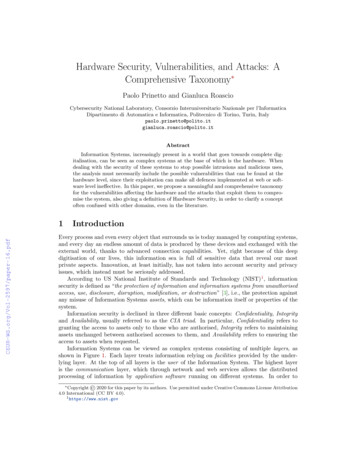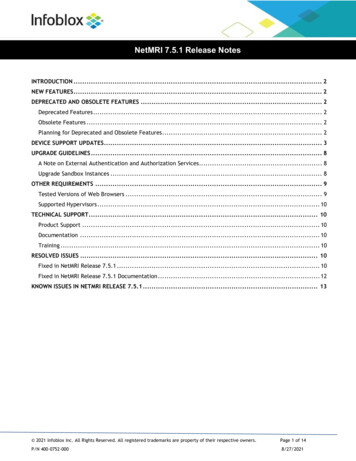
Transcription
Hardware Vulnerabilities
Hardware VulnerabilitiesImportanceA device may be designed in the US but implementedabroad. How do we know whether something maliciouswas or was not added to the implementation?Some devices are designed and manufactured abroad!It is possible to design a backdoor into hardwareHardware, of course, is the bottom level componentof systems that are critical to telecommunications, health,US economic system, and national defenseTrying to find malicious behavior in hardware is a nightmare
Hardware VulnerabilitiesHardware BackdoorA hardware backdoor might be removed by replacingthe hardware or reflashing BIOS, or firmware for net devices,graphics processing, power management, etc.A hardware backdoor might easily be installed throughreflashing BIOS, etc.A hardware backdoor typically has full access to the deviceit runs on (forget about authorization)Hardware changes may be nearly impossible to detectIt is possible to 'dope' transistors of a chip to change functionbehaviorThis was done successfully to change the random numbergenerator of Ivy Bridge intel processorsRNGs are the basis for encryption systems and abovechanges resulted in fixed output of the RNG!http://link.springer.com/chapter/10.1007%2F978 3 642 40349 1 12
Hardware VulnerabilitiesSemiconductor Dopingthe process of adding impurities to silicon-based semiconductors to change or control their electrical propertiesmaterials used to dope silicon include phosphorus, arsenic,antimony which add 'free' electrons to the silicon, causingan 'outward' current flow (n-type) and boron, gallium,aluminum, indium for fewer 'free' electrons causing an'inward' flow of current (p-type)positive voltage to the gate creates an electric field andallows current to flow from source to drain with positivevoltage from drain to source
Hardware VulnerabilitiesSemiconductor Dopinghere is what it looks like at the molecular levelA cross section of a circuit looks something like this
Hardware VulnerabilitiesSemiconductor DopingAn inverter (left) is modified to always output VDD (right)Only dopant masks are modified – changes are not visible
Hardware VulnerabilitiesSemiconductor DopingA schematic view
Hardware VulnerabilitiesSemiconductor DopingAgainst Intel's Secure Random Number GeneratorDesign verified by Cryptography Research Inc.NIST SP800-90, FIPS 140-2, and ANSI X9.82 compliantModified Trojan passes the built-in self testGenerates random numbers that pass the NISTtest suite for random numbersThe built-in self test is only designed for reportingmanufacturing defects or operational defectsthat might occur after a period of time (aging)The built-in self test does not include tests for stuck-atfaults at interconnects and output pins; are no test ports(said to improve security by leaving these out)
Hardware VulnerabilitiesSemiconductor DopingBlock diagram of the original design of the random number generatorShowing placement of the dopantEntropy Source generates random numbersEntropy of the random numbers is monitored by the OHTRandom numbers are input to the Conditioner which sometimesreseeds the Rate Matcher for random bit generation at RnRand
Hardware VulnerabilitiesSemiconductor DopingAgainst Intel's Secure Random Number GeneratorReseeding:Internal state: c, K new c, K computedc c 1, x AESK(c)c c 1, y AESK(c)K K x ss,t are the new seedc c y tfrom the conditionerRandom number generated:r AESK(c)Attack:Dope flip-flops of K so K is always constantDope 128-n flip-flops of c so c can be one of 2n numbersr depends on n random bitsOutput of AES appears random (large differencesfrom one output to the next) but only a small numberof random numbers will be generated
Hardware VulnerabilitiesState of BeingBudget cuts resulted in reduced funding for manufacturingand security validationLed to decrease in orders from 'authorized' resellers(business partner of, e.g. Apple, licensed to sell products)Orders are now mainly given to far east providers (cheaper)There are many designers and engineers associated witha product – any one could insert malicious functionalitysupporting espionage or sabotage
Hardware VulnerabilitiesCommon Hardware AttacksManufacturing backdoors, for malware or other penetrativepurposes including embedded radio-frequency identification(RFID) chips and memoryManufacturing backdoors for bypassing normalauthentication systemsEavesdropping by gaining access to protected memorywithout opening other hardwareInducing faults, causing the interruption of normal behaviorHardware modification with invasive procedures,appliances, or jailbroken softwareCounterfeiting product assets resulting in financial lossor malicious access to alification/
Hardware VulnerabilitiesAlso Hardware Side-Channel AttacksTimingPower AnalysisElectromagnetic (reading monitor content)Fault induction (smartcards)
Hardware VulnerabilitiesProducts AffectedAccess Control /access-control-hardwareNetwork Applianceshttp://www.webopedia.com/quick ref/network appliance.asphttps://www.sophos.com/en us/products/next gen firewall.aspx?cmp 70130000001xJilAAE&utm source Google&utm medium cpc&utm campaign NA NetworkIndustrial Control Systems (SCADA, DCS)https://en.wikipedia.org/wiki/Industrial control systemSurveillance Systemshttps://www.google.com/url?sa t&rct j&q &esrc s&source web&cd 1&cad rja&uact 8&ved 0ahUKEwjgqfmfm HLAhXLKyYKHc7LBBcQFghDMAA&url ssue6%2F5 6SurveillanceSystems slides.ppt&usg AFQjCNFWFzXFhwI3N2HXZbdhsVEGmxlSlg&bvm bv.117868183,d.eWECommunication InfrastructureRF, fibre, etc.
Hardware VulnerabilitiesHypothetical AttacksTime BombAn attacker might program a time bomb backdoor into HDLcode that automatically triggers backdoors after apre-determined fixed amount. A device could be forced tocrash or operate maliciously after a determined number ofclock cycles. An attacker could design a kill switch functionthat could be undetectable by any validation methods.Cheat CodesAn attacker might program backdoor triggers based onspecific input data (called “cheat codes” - secret data that anattacker uses to identify itself to hardware backdoor logic).A cheat code must be unique to avoid being accidentallyprovided during validation tests. An attacker could providecheat codes which send a single data value containing theentire code (single-shot “cheat codes”) or a large cheat codein multiple pieces (sequential “cheat codes.”)
Hardware VulnerabilitiesAttack MotivationIntellectual PropertyClone hardware: steal the designLeak information: enable copy of design, then implementedTheft or diversion of ServiceRedirect packets to another server which may do anythingfrom planting malicious code to delivering unwanted adsEnter a systemBypass access controls to do anything from setting upcommand and control for future attacks to gatheringemployee information with spam delivery in mind, tounlocking hidden features, to unlocking devices
Hardware VulnerabilitiesHistoryBombePlaintext attack against Enigma cipher machinesDynamic mapping of keys to cipher charactersAttack took advantage of1. Poor operational control of the machine esp. in the fieldEarly training manual had example encryptions!Many messages began with ANX – 'to' with 'X' spacerOnly six plugboard leads were usedSome operators used 'HIT' 'LER' to set keysSome operators used German obscenities to set keysSame messages were sent by Enigma and 2nd cipherLots more.2. The 'reflector' required that no key could map to itself3. Rotor notches were in different positions so wheel ordercould be determined by observing when the middlerotor was turned over by the rightmost rotor
Hardware VulnerabilitiesHistoryRowhammer AttackDRAM (memory) cells (mainly found in X86 computers)influence each other because they are densely packedA given row of memory can cause bits in another row to flipOn laptops manufactured from 2010-2014, involving fivedifferent DRAM vendors 15 of 29 could be attackedsuccessfully to escalate privilege and allow access to allphysical memory – bit flips were induced in page tableentriesDesktops were not vulnerable, using ECC DRAM
Hardware VulnerabilitiesHistoryThingbots (e.g. refrigerators) send spamApproximately 2014 – 100,000 or so TVs, routers,refrigerators sent 750,000 spam messagesSmall number sent from each IP address – hard to protectagainst"Many of these devices are poorly protected at best andconsumers have virtually no way to detect or fix infectionswhen they do occur. Enterprises may find distributedattacks increasing as more and more of these devicescome on-line and attackers find additional ways to exploitthem." – David Knight, ProofpointSmart power meters could be vulnerable – imagine powerbeing turned off to all customers of a city at one time
Hardware VulnerabilitiesHistoryHardware Involved Software tures/PDF/Forristal Hardware Involved Software Attacks.pdfSee page 16 and following
Hardware VulnerabilitiesHardware Lifecycle TrustMalicious mods to an IC should be detectable by pre-siliconverification/simulation and post-silicon testingBut, this requires a golden model of the entire IC whichmight not be available, e.g. for IP designs from 3rd-party vendorsAnyway, verification is currently not practical for complex circuitsPost-manufacturing logic testing doesn't work because attackerbuilds trigger on rare circuit event to avoid detection
Hardware VulnerabilitiesClassification of Hardware TrojansCombinationally triggered Trojan – subclass of digitally triggeredOccurrence of condition A 0, B 0 at the trigger nodes A, Bcauses payload node C to have an incorrect value at Cmodif iedAttacker chooses a rare activation condition from low-controllableinputs making trojan unlikely to trigger during manufacturing test
Hardware VulnerabilitiesClassification of Hardware TrojansSequentially triggered, synchronous Trojan (Time Bomb) –subclass of digitally triggeredTrigger is at a particular count of a circuit component that countsNormal output ER is diverted to an xor gate and controlled by thetrigger outputThe idea is to trigger on a rare sequence of events
Hardware VulnerabilitiesClassification of Hardware TrojansSequentially triggered, asynchronous Trojan (Time Bomb) –subclass of digitally triggeredTrigger is at a particular count of a circuit component that countsBut p and q changing to cause a change in the output of the ANDgate on the left is what drives the countThe idea is to trigger on a rare sequence of events
Hardware VulnerabilitiesClassification of Hardware TrojansHybrid triggered Trojan – subclass of digitally triggeredTrigger point depends on synchronous and asynchronous countsMore challenging to detect sequential Trojans using conventionaltest generation and application: requires satisfying a sequenceof rare conditions at internal circuit nodes to activate themUnmanageably large number of events for logic testing approach
Hardware VulnerabilitiesClassification of Hardware TrojansAnalog triggered TrojanTrigger point depends on on-chip sensorsIn this example, capacitor voltage rises and falls as q1 and q2values change. After a long time, voltage goes high enough toregister a value in the xor gate, triggering the Trojan
Hardware VulnerabilitiesClassification of Hardware TrojansAnalog triggered TrojanTriggered when high activity raises chip temperature that issensed by the temperature sensorNote: by adding circuitry to raise activity of the chip, an attackeralso ages the chip faster – this is considered a form of attack
Hardware VulnerabilitiesClassification of Hardware TrojansTrojans can also be classified on their payload typeDigital payload: can either affect the logic valuesat chosen internal payload nodes, or can modifythe contents of memory locationsAnalog payload: can affect performance, power margin,noise margin, and other circuit meta functions. Additionof resistor to circuit on the left causes a bridging fault(two signals connected when they should be isolated)addition of capacitor on the right causes delay intransmission of signal
Hardware VulnerabilitiesTrojan DetectionTaxonomy of hardware Trojans is helpful because there isno one technique that is effective on all Trojan types.
Hardware VulnerabilitiesTrojan DetectionDestructive detectionA sample of the manufactured ICs are subject tode-metallization using Chemical Mechanical Polishing(CMP) followed by Scanning Electron Microscope (SEM)image re-construction and analysisVery expensive, does not scale well with circuit complexityMay take as long as several monthsCan only be applied to a small sample of the chipsAn attacker may infect only a portion of the manufacturedchips hence, the ones selected for testing may not beinfected and cannot validate trust
Hardware VulnerabilitiesTrojan DetectionNon-destructive, invasive for preventionObjective: prevent trojan insertion during design orfabrication of the ICTrojan insertion requires “dead space” for attacker toadd circuitry – attacker cannot increase die areaBut attacker, with knowledge of the netlist, may be ableto redesign optimally to make some spaceDesign technique: obfuscate the original design to makeit harder for the attacker to determine functionalityWithout complete knowledge of functionality the attackerwill not be sure enough about adding circuitry that willnot be detected by functional testing or that will betriggered eventually
Hardware VulnerabilitiesTrojan DetectionNon-destructive, invasive for preventionObjective: prevent trojan insertion during design orfabrication of the ICDesign technique: enable transparency modeExecute on probably rare events, create executionsignatures from primary outputs, compare againstexpected signatures
Hardware VulnerabilitiesTrojan DetectionNon-destructive detectionSide channel signals (timing and power)Trojans typically degrade performance, changepower characteristics, or introduce reliability problemsin the chipThis influences power and/or delay characteristics ofwires and gates in the affected circuitPower-based side-channel signals provide visibility ofthe internal structure and activities within the IC, enablingdetection of Trojans without fully activating themTiming-based side channels can detect a Trojan’spresence if the chip is tested using efficient delay teststhat are sensitive to small changes in the circuit delayalong the affected paths and that can effectivelydifferentiate Trojans from process variations
Hardware VulnerabilitiesTrojan DetectionNon-destructive detectionSide channel signals (power)Assume attacker inserts Trojan randomly in some chipsA “Golden Die” is created and measurements taken (right)A “minimum” curve for trojan-free dies is developed (solid line)A chip operating below the solid line is assumed to be hackedThis test can be done for all chips and does not require too muchtime
Hardware VulnerabilitiesTrojan DetectionNon-destructive detectionSide channel signals (timing)Shadow register measures register-register path delaysCLK2 synced to CLK1 but at a controlled phase offsetThe results latched by the destination register and the shadowregister are compared during every clock periodIf the comparison is unequal, the path delay is suspectNote this is a runtime test AND a manufacturer's test
Hardware VulnerabilitiesTrojan DetectionNon-destructive, non-invasive for detectionObjective: compare given IC properties with propertiesof the “Golden” IC instance or “Golden” functional modelDetect at runtime:Previous slideAdd circuitry to enable real-time functional monitoringCountermeasures can be executed if checks failMonitor bus behavior and report malfeasanceRun multiple instances of functionally identical codeon many CPU cores, compare and evaluate outputsChange the operating system to make functional checkson the hardware
Hardware VulnerabilitiesTrojan DetectionNon-destructive, non-invasive for detectionObjective: compare given IC properties with propertiesof the “Golden” IC instance or “Golden” functional modelDetect before deployment:Require much performance and power overheadBut are capable of 100% confidenceTry all test vectors is infeasible, statistical methods usedGive higher probabilities to test vectors that trigger rareevents multiple times (see next slide for results)Examples:Two and three slides backGenerate power and timing statistics on “good” chipsCompare during testing of manufactured chips
Hardware VulnerabilitiesTrojan DetectionNon-destructive, non-invasive for detectionLogic Testing for hardware Trojan detectionN number of times a rare point satisfies its rare valueC3540: 451 gates, 1011 Trojan payload nodes are possible4 trigger nodes (internal interconnects), single payload node.
Hardware VulnerabilitiesTrojan DetectionNon-destructive, non-invasive for detectionA region: a portion of the layout that receives the majorityof its power from surrounding power ports (Trojans here?)Regions are identified to establish likely Trojan insertionpointsNew test patterns concentrating on the identifiedregions are applied to magnify the disparity between theoriginal and any Trojan-inserted circuits – power signaturesare recorded and compared to the “Golden” resultsWhere indecisive results are obtained, additional testpatterns are devised – thus there is an incrementalincrease in the total number of vectors needed untilsatisfactory confidence is achieved
Hardware VulnerabilitiesTrojan DetectionComparisonLogic TestingSide-ChannelGoodEffective for smallTrojansRobust underprocess noiseEffective for largeTrojansTest generation iseasyBadTest generation iscomplexLarge Trojan detectionis challengingVulnerable to processnoiseSmall Trojan detectionis challenging
Led to decrease in orders from 'authorized' resellers (business partner of, e.g. Apple, licensed to sell products) . - David Knight, Proofpoint Smart power meters could be vulnerable - imagine power being turned off to all customers of a city at one time. Hardware Vulnerabilities History Hardware Involved Software Attacks










